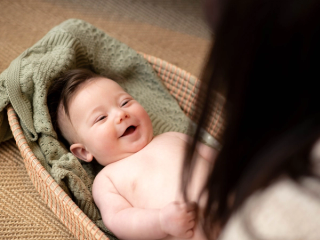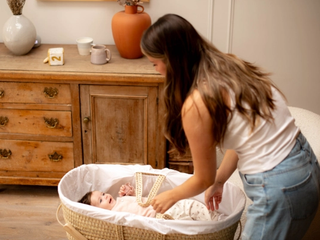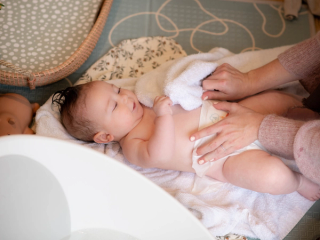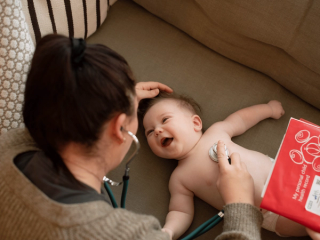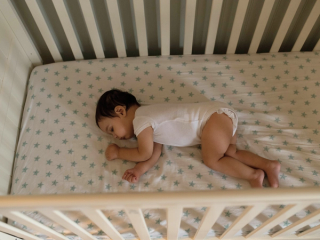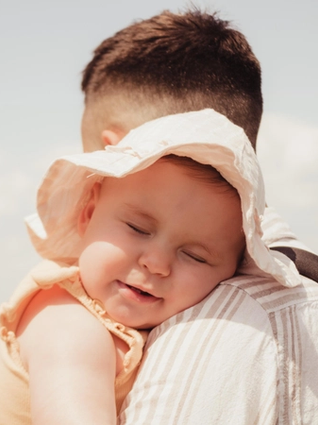
- Home
- Advice Hub
- Newborn
- Essential Newborn Care
- Looking After Your Little One's Skin In The Sun
Looking after your little one's skin in the sun
Babies' skin is extra sensitive to sunlight. Learn simple ways to protect your little one in warm weather and keep their skin safe during sunny days.
Babies and young children have much more delicate and sensitive skin than adults, which means they need extra care and attention - particularly during the warmer months and in strong sunlight. In this article, we’ll explore why sun protection is so important for young skin and share simple, practical steps you can take to help keep your little one safe in the sunshine.
Why is protecting your child from the sun important?
It’s important to protect young children and babies from the sun as they are more prone to sunburns. Their skin is much thinner and contains less melanin - the natural pigment that provides some protection against the sun’s rays. Sun damage is also cumulative, which means that sun damage over time can build up and increase the chances of developing skin cancer later in life. In fact, even just one episode of blistering sunburn in childhood or adolescence can almost double the risk of developing skin cancer as an adult. Young children are also at a greater risk of heat-related illnesses, such as heat exhaustion and heat stroke, which can happen quickly in hot weather.
That’s why it’s so important to make sun protection part of your child’s daily routine from a young age and not just on hot, sunny days. Babies under six months should be kept out of direct sunlight, older babies should also be kept out of the sun whenever possible especially during the summer months and during midday when the sun is at its strongest.
What is UV radiation?
Ultraviolet (UV) radiation is a type of invisible energy that comes from the sun and it can also be produced by artificial sources like sunbeds. There are two types of UV rays, UVA and UVB. UVA rays can pass through window glass and reach deeper into the inner layer of the skin, where they break down collagen and elastin - leading to premature ageing. UVB rays affect the top layers of your skin and are the main cause of sunburns. Both UVA and UVB rays can increase the risk of skin cancer. Over time, repeated exposure to UV rays, even without obvious sunburn, can increase the risk of skin damage and skin cancer later in life.
How to protect your baby from UV radiation?
Here are some simple steps that you can take to protect your little one’s skin in the sun:
Apply sunscreen
For babies over six months old, it's important to apply a broad-spectrum sunscreen with SPF 50+ to all areas of exposed skin - don’t forget the ears, back of the neck and top of the feet. Look for a gentle, child-friendly formula - ideally a physical (mineral) sunscreen containing ingredients like zinc oxide or titanium dioxide, which sit on the skin’s surface and act as a protective barrier against the sun’s rays. Apply sunscreen around 30 minutes before heading outside, even on cloudy days, and remember to reapply every two hours or after your baby has been in the water. For babies under six months, it’s best to keep them out of direct sunlight.
Keep them covered and use sunhats
Dress your baby in lightweight, long sleeved clothing. Fabrics with a close-weave offer better protection against the sun’s rays. You can also find clothing labelled with UPF (ultraviolet protection factor) ratings for added reassurance. A wide brimmed sun hat that shades your baby’s face, neck and ears is also important, you might find ones with chin straps are easier to keep on.
Wearing sunglasses
Babies eyes are sensitive to UV light just like their skin. If your baby tolerates sunglasses, it's a good idea to protect their eyes with baby specific sunglasses with wrap around lenses or wide arms, that offer UV protection and have the CE and British standard mark.
Avoid being out and about when the sun is at its peak
The sun’s rays are strongest in the middle of the day between 11am and 3pm, especially from March to October. During these times avoid being out with your little one or keep them in the shade if you are outdoors. Find shade under a parasol, umbrella, tree canopy or use a sunshade on the baby’s pram. It might also be helpful to be aware of the UV index for the day so that you can take extra precautions if needed.
What should I do if my child gets a sunburn?
If your little one sustains a sunburn, it’s important to act quickly and seek medical attention from a healthcare professional if required. Symptoms can include skin which is warm, red and painful. Here are some steps to ease the symptoms:
- Remove your child from the sun immediately and keep them in a cool shaded area
- Cool the skin with a cool (not cold) shower, bath or damp towel
- Apply a soothing moisturiser or aftersun cream
- Consider giving paracetamol or ibuprofen to reduce any swelling, redness or discomfort (always check the medication is suitable for your child and the correct dose).
- Keep them hydrated with plenty of fluids and to help cool them down
- Cover sunburnt skin from direct sunlight until skin has fully healed, use loose and soft clothing to avoid irritation
- If there are signs of serious sunburn, such as the skin is blistered or swollen, high temperature, dizziness, headaches, signs of dehydration - seek medical attention straight away.
Sun safe tips for babies and children
Patch test the sunscreen
Before using any new sunscreen, especially on babies and young children with sensitive skin, do a patch test - apply it to a small area the first time and wait 24 hours to see if any irritation develops. You can also find specially adapted sunscreens for babies and young children that cater for their sensitive skin.
Stay hydrated
Other important considerations to remember when babies and young children are in the sun is to keep them well hydrated with cool fluids, and keep them cool in light, loose clothing. Ensure adequate rehydration in hot weather; it might be that you need to increase feeding frequency to keep their fluids up.
Keeping cool
Set up a shaded area in the garden with a parasol or canopy and consider using a shallow paddle pool for supervised play. Always ensure the water is clean, cool (not cold) and that your child is never left unattended. Indoors use a fan, or cool damp flannels to help regulate body temperature and dress your baby in light, breathable clothing.
Conclusion
Keeping young children safe in the sun might feel like a big task at first, but starting early with the right habits and choosing the right products for their skin makes all the difference. By making sun protection part of your everyday routine and keeping it fun and engaging, you’re not only protecting their delicate skin now, but also helping them build healthy sun-safe habits that will last a lifetime.
Frequently asked questions around sun safety
Babies under 6 months old should avoid exposure to direct sunlight. Young children should be kept out of the sun and in the shade, especially between 11am and 3pm in the summer months, when the sun is at its strongest and the simple sun safety steps that have been discussed in this article should be followed.
Yes, babies can get sunburnt in the shade. UV rays can reflect off surfaces and also pass through clouds. So even if your baby is in the shade or it's a cloudy day, appropriate sun protection is still vital.
Yes, heatstroke is a serious risk for babies, especially in hot weather. Babies have less ability to regulate their body temperature, making them vulnerable to heat stroke.
Heatstroke or sunstroke needs to be treated as an emergency and you should seek immediate medical help if you suspect this. Symptoms can include: irritability, vomiting, high temperature, pale and clammy skin, fast breathing, and lethargy. You can learn more about heat exhaustion and heat strokes on the NHS website.
The information in this article is for education purposes and should not replace professional medical advice. Always consult medical professionals/your healthcare provider for diagnosis and treatment.

